Maya Lin: A Study of Water
PDF: Brittain, review of Maya Lin
Curated by: Melissa Messina
Exhibition schedule: Virginia Museum of Contemporary Art, April 21–September 4, 2022
The Virginia Museum of Contemporary Art’s exhibition Maya Lin: A Study of Water expertly navigated the surging tension between the global and the local in ecocritical art history (as well as in Lin’s oeuvre). Lin drew on extensive ecological knowledge in “poetic representations of the Chesapeake Bay in glass marbles and silver presented alongside rivers made of steel pins, icebergs made of plaster, and waves made of wood.”1 Guest Curator Melissa Messina’s panel texts crisply captured the interconnected themes of climate change, ice melt, deforestation, and sea level rise in a way that was equally rich for those well-versed and those coming to the topics for the first time, revealing, in Lin’s words, “things we may not be thinking about.”
Maya Lin: A Study of Water is a relatively small exhibition, comprising one large gallery of sculptural work and two smaller galleries. One is a physical manifestation of Lin’s extensive online memorial project What Is Missing?, and the other is a space to engage tactilely with the materials used in the show and with texts related to ecology, climate change, and bodies of water. The exhibition, although limited in scale, is a deep investigation of what water means, and has meant, for life on this planet and in this particular place. Messina used Lin’s work to engage bodies of water ancient, present, imagined, global, and local.
In a smaller gallery at the back of the exhibition, Messina considered the global dimensions of Lin’s work with a physical iteration of the artist’s massive online memorial What Is Missing?, which Lin began in 2009. This memorial is about pollution, habitat loss, species extinction, forced human migration, and other ill effects of climate change. In the gallery, infographics demonstrated the impact of pragmatic individual and governmental actions, titled with, for example, “What if we ate 20% less meat?” and “What if we subsidized good practices rather than bad?” The collective spirit of the online memorial was embraced in this physical iteration by inviting visitors to contribute their own memories of specific ecosystems on brown-paper circles placed atop a simple gray silhouette of the Earth’s landmasses (fig. 1). Via Lin’s work, the exhibition also focused on specific bodies of water, including the local Chesapeake Bay.
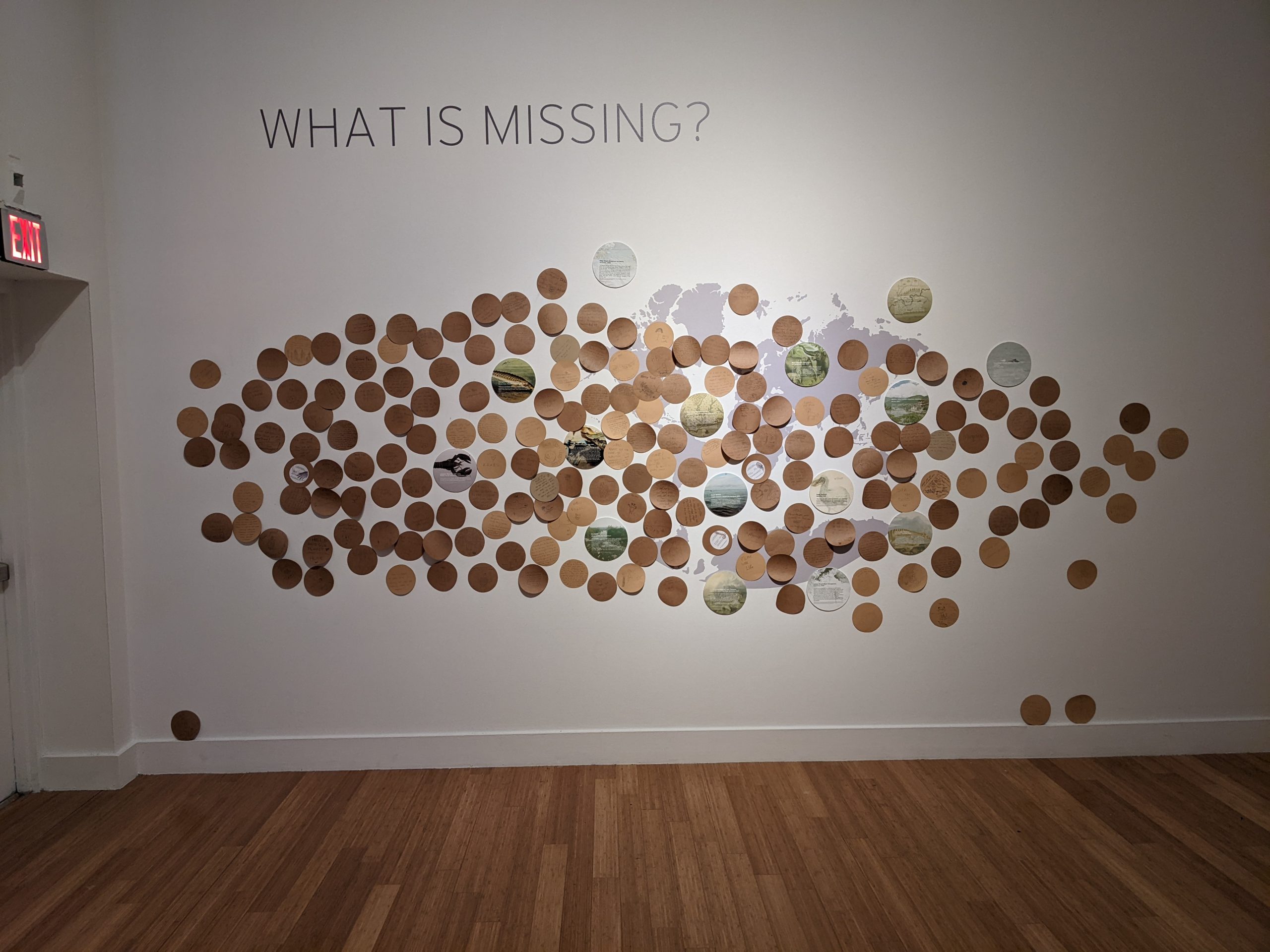
Specifically, the show considered the states of water and their relationship to climate change. As visitors entered the exhibition, the blown-glass sculpture Dew Point 42 dotted the floor, leading toward Imaginary Iceberg, a plaster maquette capturing the supra- and subsurface contours of icebergs (fig. 2). Together, these two sculptures represent the main sources of rising sea levels caused by climate change: warming waters and melting ice. An earlier work by Lin, White Fracture, also offered a meditation on ice’s shifting materiality. Produced by running glass through a printing press along with the paper, the works reveal how the pressure shatters the glass, leaving subtle impressions akin to breaking ice.
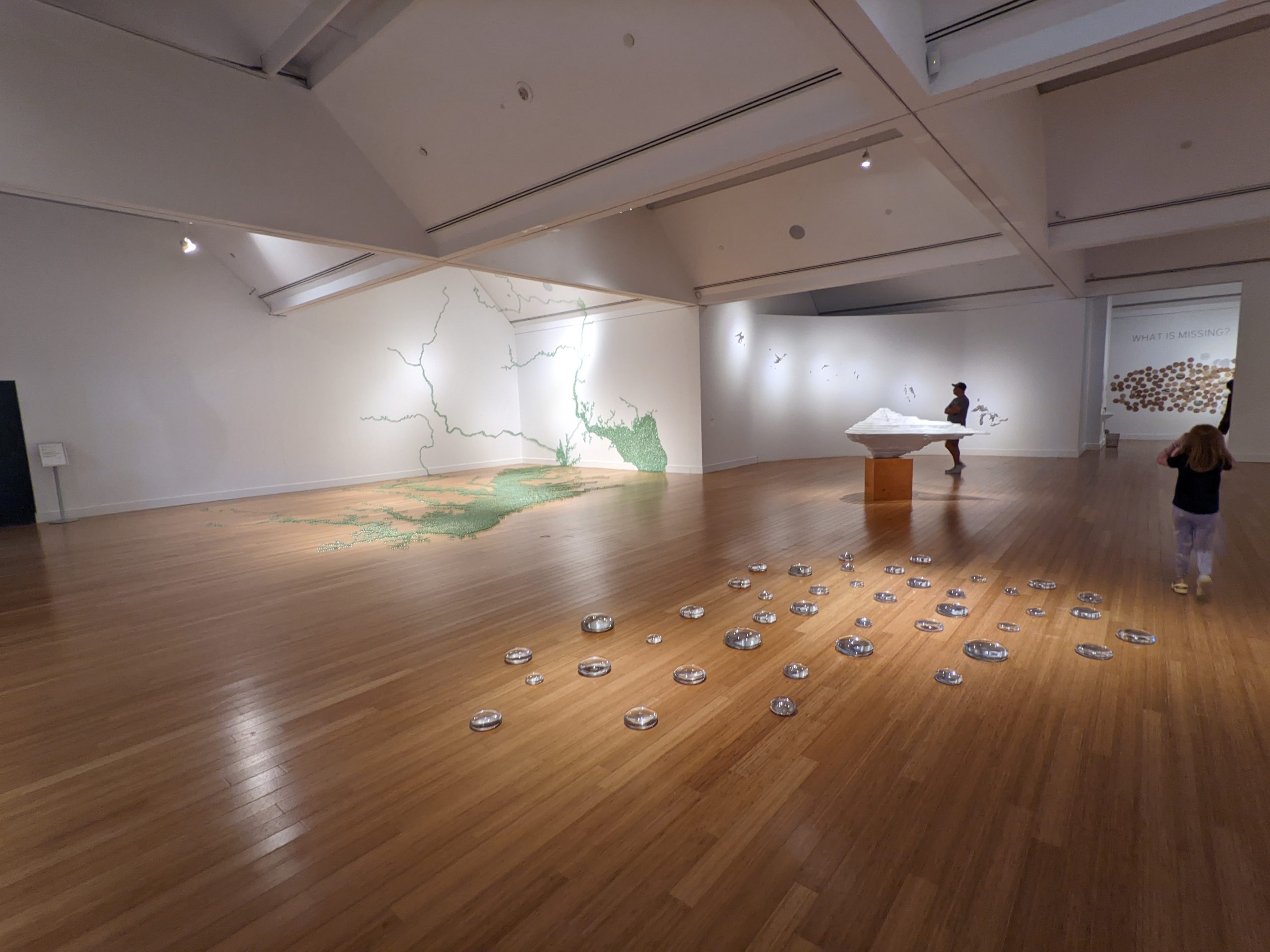
Far beyond a mere examination of the present anthropogenic climate crisis, Lin, and by extension the exhibition, is also interested in longer timescales. The curved wall pictured behind Imaginary Iceberg establishes a panoramic setting for The Traces Left Behind (From the Great Bear Lake to the Great Lakes). The left-to-right and top-to-bottom orientation of these recycled silver “traces” roughly follows the geographic positioning of the lakes, west to east and north to south, from the Northwest Territories of Canada to the Northern United States. Each lake depicted in the work was created by the melting of the Laurentide Ice Sheet approximately twenty thousand to around eight thousand years ago. The molten state silver must be in to achieve such clear and complex forms, once again, reflects the mutable character of water. Another sculpture, similarly made of recycled silver and simply titled Silver Chesapeake, also presents one of the representations of the bay in the exhibition. In the object label for Silver Chesapeake, Lin asks: “Can we freeze a moment that is always in flux? Can I reveal aspects of the natural world that you may not even realize are shifting?” The encaustic sculpture The Deglaciation of the Laurentide captures in relief the ice sheet’s subtilized topography as it diminished. The Traces Left Behind (Finger Lakes) (fig. 3) likewise represents the phenomenon of the Laurentide’s melting, its convex grooves created by the artist simulating the sculpting effect of ancient glacial movement.
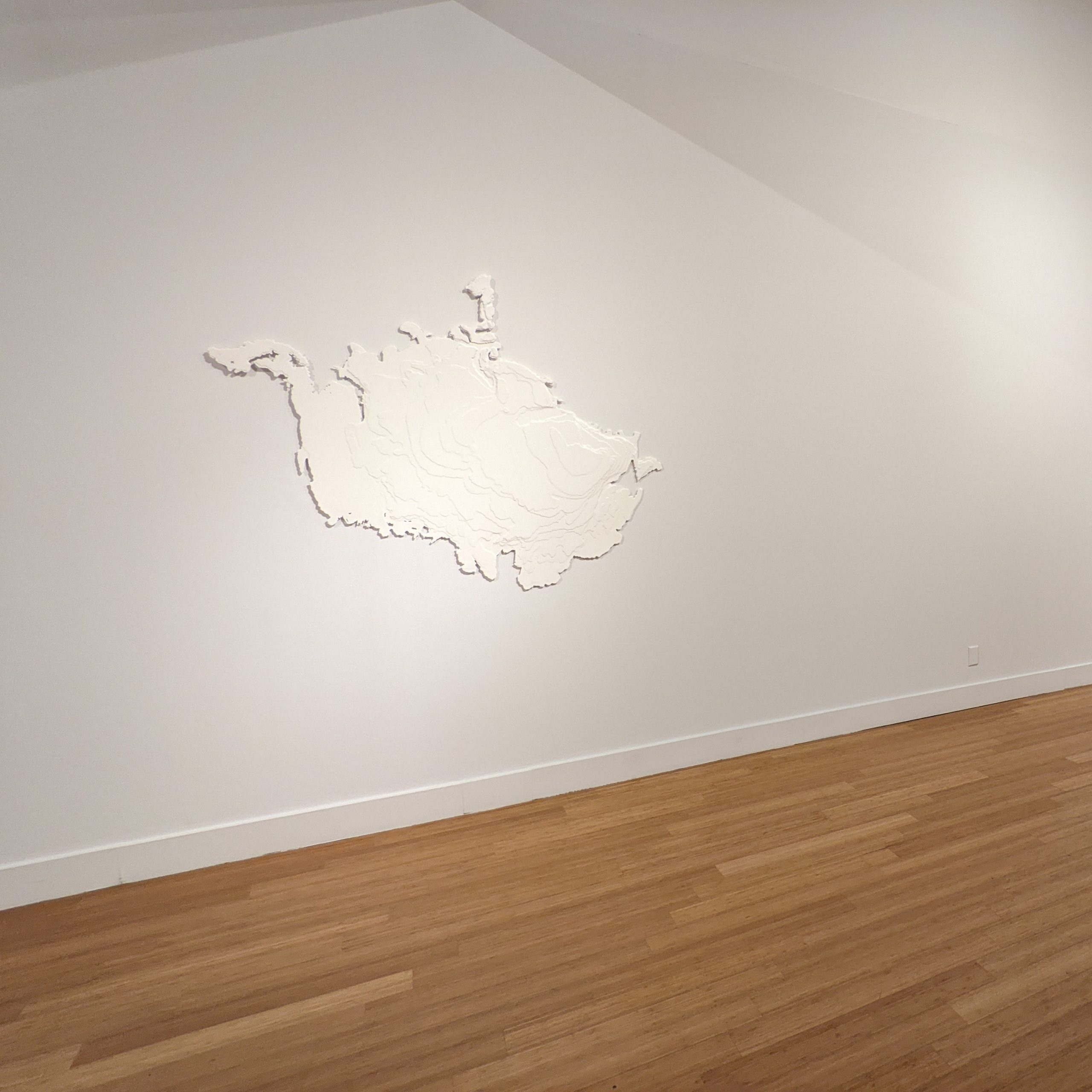
The monumental wood sculpture Flow (fig. 4) undulates, conjuring the motion of water in its liquid state. As the curator writes in the label text, “By portraying water with thousands of recycled pieces of wood, Lin calls to mind the harmful effects of deforestation, including the increased severity and frequency of hurricanes and tsunamis it causes.” Lin recognizes the interconnected ecologies of forests and waters. The label text also astutely referenced Lin’s 2021 installation Ghost Forest, an installation that relocated forty-nine Atlantic white cedars poisoned by rising saltwater on the New Jersey coast to Madison Square Park Conservancy in New York City. Ghost forests are all-too-familiar monuments of climate change for residents of coastal Virginia, who see this real phenomenon in their daily lives. Flow and its interpretation spoke to viewers by connecting this local problem to broader issues.
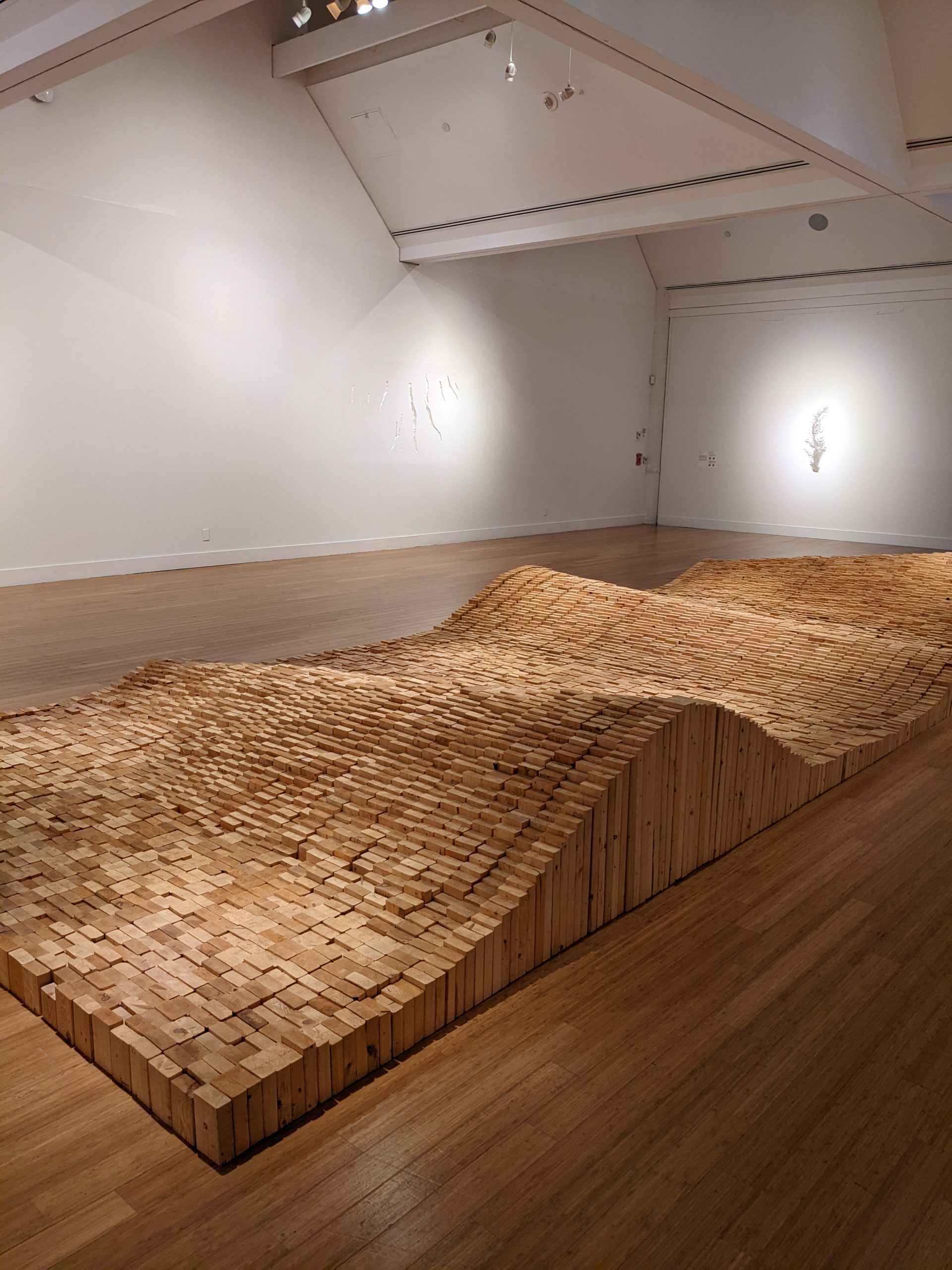
The show’s signature work, Marble Chesapeake & Delaware Bay (fig. 5), an installation of clear-glass marbles in the shape of the bay’s aerial footprint, covers an expanse of the gallery floor and climbs up two of its walls. The work emulates the fluidity of water and the flows of global commerce that rely on the bay’s ports. It also dramatically symbolizes sea-level rise, an ever-present threat to coastal communities, like the museum’s hometown of Virginia Beach, which is precariously situated at the confluence of the Chesapeake Bay and the Atlantic. This work at once memorializes the bay as it exists at present and evokes its shifting edges.
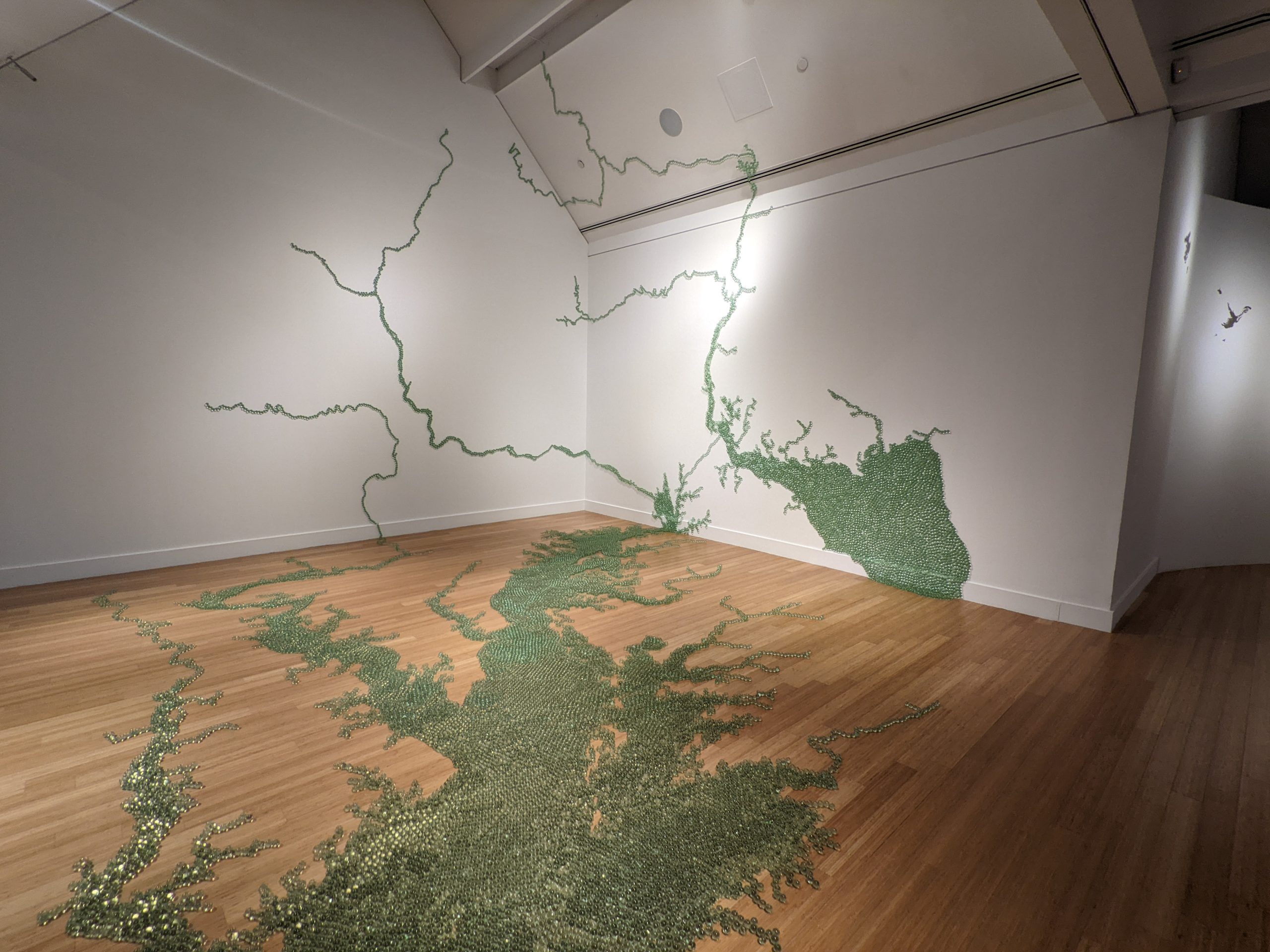
Like so much of Lin’s work and certainly the installations in this show, Marble Chesapeake & Delaware Bay is temptingly tactile. While visitors are not allowed to touch the actual works, in an adjacent gallery, sample “Please Touch” installations using the marbles and other media provide an opportunity for visitors of all ages to delve deeper into the materials used and the issues examined in the exhibition. This section offers another sensory access point with these materials and also has a shelf of books for kids and adults on related ecological topics, including Nick Estes’s Our History Is the Future: Standing Rock versus the Dakota Access Pipeline, and the Long Tradition of Indigenous Resistance, which provides a perspective largely absent from the exhibition’s artworks. The exhibition does attempt to bring in some additional voices while simultaneously including a mechanism for auditory engagement. Placed next to most label texts were QR codes to the series Collective Voices that features audio recordings by ecosystem scientist Chris Moore of the Chesapeake Bay Foundation, Poet Laureate of Virginia Luisa Igloria, local high school students, and others. While an exciting concept, nothing on the website prompted visitors to bring headphones and none were available at the museum. Unless you happened to have them with you, there was not a way to listen without disrupting other visitors nor any alternative means to access the audio. This oversight likely resulted in visitors missing out on a potentially exciting enhancement to the exhibition experience. Moreover, by placing the labels as written text in the galleries and only making the Collective Voices accessible by QR code on a secondary device, the exhibition missed the opportunity to cede curatorial authority in a more meaningful way.
The curators did successfully bring new practitioners into the fold, however, with a companion show of exterior sculptures collaboratively designed and built by area high school students. Interrupted Flow in Nature: Earth, Water, Air, produced by students from Churchland High School in Portsmouth, for example, used broken slabs of clay to represent earth and our (at present) fractured, incomplete efforts to repair it. Melted clear, blue, and green plastic signify water, with its flows interrupted by the very material used here to symbolize it. By involving those most intimately connected to the bay—and those who will likely have to solve the problems of its inundation in the future—the exhibition made a final hopeful turn, from a gallery focused on what will be lost to an engagement with those who will stand resilient, preventing the worst effects of climate change and the resulting sea-level rise.
Cite this article: Morgan J. Brittain, review of Maya Lin: A Study of Water, Virginia Museum of Contemporary Art, Panorama: Journal of the Association of Historians of American Art 9, no. 1 (Spring 2023), https://doi.org/10.24926/24716839.17445.
Notes
I am grateful to Jessica Skwire Routhier, Annika Fisher, Mora-Beauchamp-Byrd, and Liz Kim for their thoughtful edits and to Alan C. Braddock for conversations that always improve my thinking. Thanks, too, to Sara Hales-Brittain, my exhibition and all-things partner, and to Fitz, my writing buddy.
- Both quotations are from the introductory panel text, Maya Lin: A Study of Water, Virginia Museum of Contemporary Art, April 21–September 4, 2022, viewed August 6, 2022. Such tensions between the global and the local are also addressed by Timothy Morton, The Ecological Thought (Cambridge, MA: Harvard University Press, 2010) ↵
About the Author(s): Morgan J. Brittain is a PhD candidate in American Studies at the College of William & Mary

